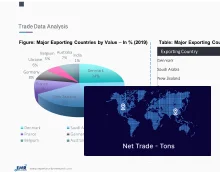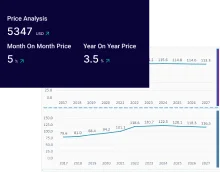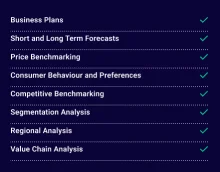
Consumer Insights
Uncover trends and behaviors shaping consumer choices today
Procurement Insights
Optimize your sourcing strategy with key market data
Industry Stats
Stay ahead with the latest trends and market analysis.
The sciatica treatment market size was valued at USD 5.32 Billion in 2025. The market is projected to grow at a CAGR of 4.50% during the forecast period from 2026 to 2035, with values expected to reach USD 8.26 Billion by 2035. North America holds a significant market share due to advanced treatment options and high healthcare spending.
Base Year
Historical Period
Forecast Period
Compound Annual Growth Rate
4.5%
Value in USD Billion
2026-2035
*this image is indicative*
Sciatica (lumbar radicular pain) occurs when the sciatic nerve is compressed, irritated, or inflamed, often causing pain from the lower back to the legs. The prevalence of sciatica is rising due to aging populations and sedentary lifestyles. Common causes include herniated disks and overgrowth of spinal bone. Treatment options range from physical therapy to medications like corticosteroids, which help reduce inflammation and pain.
The annual incidence of sciatica is notable, affecting a large global population. Back pain is one of the most common medical conditions in the United States with 35% of adults aged 50 to 59 reporting chronic low back or sciatic pain. The lifetime incidence of sciatica is high, with many individuals experiencing symptoms at least once in their lifetime.
Treatment advancements include epidural steroid injections and analgesics for pain relief. Leading market players invest in clinical trials to develop innovative therapies. Increasing awareness and technological advancements contribute to market growth, with a growing focus on non-invasive and long-term treatment solutions.
Reduced Patient Hospital Visits During the COVID-19 Pandemic Impacted Market Growth
The COVID-19 pandemic disrupted the market, as healthcare facilities prioritized emergency cases over non-urgent conditions. Lockdowns, movement restrictions, and fear of infection led to a sharp decline in hospital visits. Many patients postponed consultations, delaying diagnoses and treatments. Additionally, disruptions in medical supply chains affected the availability of essential medications and equipment. The reduced access to healthcare services significantly hampered market growth during the peak of the pandemic.
As restrictions eased, the sciatica treatment market gradually recovered. Healthcare facilities resumed routine operations, addressing the backlog of untreated cases. Telemedicine emerged as a crucial alternative, enabling remote consultations and prescription management. Market players adapted by strengthening supply chains and increasing digital healthcare solutions. However, the long-term impact of delayed treatments remains a concern, with increased demand for physical therapy, medications, and surgical interventions expected in the coming years. Improved healthcare infrastructure and technological advancements are likely to drive market recovery and future growth.
Several trends and developments are being observed in the market to enhance the current situation. Some of the noteworthy trends are as follows:
Increasing Incidence of Sciatica
The prevalence of sciatica is rising globally, affecting millions of individuals. It is a widespread condition, with an incidence rate reaching up to 43% in the general working population. Factors such as prolonged sitting, obesity, and ageing contribute to this increase. The growing burden of musculoskeletal disorders further drives demand for effective treatments. Healthcare advancements, early diagnosis, and patient awareness are essential in managing the rising cases. As more individuals seek treatment, the sciatica treatment market continues to expand, fostering research and development efforts for innovative solutions.
Advancements in Treatment Approaches to Meet Market Demand
The sciatica treatment market is evolving with the introduction of innovative therapies. Traditional treatments like physical therapy and pain medications are now complemented by targeted drug delivery systems and minimally invasive procedures. Regenerative medicine, including stem cell therapy and platelet-rich plasma (PRP) injections, is gaining traction. Non-opioid analgesics and biologics are also being developed to reduce dependency on conventional painkillers. These advancements enhance treatment efficacy, reduce recovery time, and improve patient outcomes, driving greater adoption and expanding the market's growth potential.
Lifestyle Changes Increasing Sciatica Cases
Modern lifestyles contribute to the rising prevalence of sciatica. Prolonged desk jobs, lack of physical activity, and poor posture increase the risk of sciatic nerve compression. Obesity, a major factor, puts excessive strain on the spine, leading to nerve impingement. Additionally, an aging global population faces higher risks of spinal degeneration, herniated discs, and nerve-related conditions. These factors highlight the urgent need for accessible and advanced treatment solutions. As sedentary habits persist, the demand for sciatica treatments continues to rise.
Strategic Market Initiatives Driving Growth
Key players in the sciatica treatment market are actively investing in research, partnerships, and new product developments. Companies focus on expanding their product portfolios and enhancing pain management solutions. For instance, in March 2025, MIRA Pharmaceuticals announced the successful formulation of Ketamir-2 into a topical treatment for localized neuropathic and inflammatory pain. This innovation expands its pain management portfolio, offering a targeted approach to conditions like sciatica while reducing systemic exposure and side effects. Such strategic initiatives strengthen market presence and drive future growth.
Adverse Effects of Chronic Sciatica Treatment May Hinder Market Expansion
The long-term use of medications for chronic sciatica, including opioids, NSAIDs, and corticosteroids, often leads to significant side effects. Patients may experience gastrointestinal issues, cardiovascular risks, dependency, or kidney damage. These adverse effects limit prolonged treatment adherence and raise concerns among healthcare providers. Additionally, invasive procedures like epidural steroid injections and surgeries carry risks of complications, further restraining market growth.
The increasing awareness of these risks has led to a shift toward alternative therapies, such as physical therapy, acupuncture, and regenerative medicine. Regulatory authorities are also imposing stricter guidelines on opioid prescriptions, affecting market dynamics. While innovation in treatment options continues, conventional therapies' safety concerns may slow market expansion. Addressing these limitations through safer, more effective solutions is crucial for sustaining long-term growth in the market.
Chronic Sciatica Segment Dominates Due to High Steroid Use
Based on type, the market is divided into acute sciatica and chronic sciatica. The chronic segment holds a significant share due to its prolonged nature, requiring ongoing treatments like steroid injections and NSAIDs. The rising prevalence of degenerative spine conditions further drives demand.
Acute sciatica is another type of sciatica that resolves within weeks with conservative treatments like NSAIDs and physical therapy. However, increasing awareness of early intervention supports growth.
NSAIDs Lead Due to High Prescription Rates
Based on drug class, the market includes NSAIDs, corticosteroids, antidepressants, and others. NSAIDs hold a major share of the market due to their effectiveness, affordability, and availability as both prescription and over-the-counter medications.
Corticosteroids follow closely due to their strong anti-inflammatory properties. Epidural steroid injections are widely used for chronic cases requiring stronger pain relief. Anticonvulsants are expected to grow significantly due to increasing research supporting their role in neuropathic pain management and their potential as opioid alternatives.
Retail & Online Pharmacies Drive Market Growth
Based on distribution channels, the market includes hospital pharmacies, retail pharmacies, and others. Retail pharmacies hold a substantial share of the market due to high out-of-pocket spending, easy access, and wide drug availability.
Hospital pharmacies have a significant share, mainly serving patients undergoing advanced treatments like steroid injections. Strict regulations further support growth. The "others" category, including online pharmacies, is growing rapidly due to increasing demand for digital health solutions and home delivery services.
The regions included in the market are the United States, EU-4 (Germany, France, Italy, Spain), the United Kingdom, Japan, and India. The United States holds a significant market share due to its advanced healthcare system and high awareness of pain management. Back pain is one of the most common medical conditions in the U.S., with 35% of adults aged 50 to 59 reporting chronic low back or sciatic pain. Rising demand for non-opioid treatments and minimally invasive procedures is driving market growth.
The EU-4 and the United Kingdom are experiencing significant market growth due to increasing awareness, aging populations, and favourable reimbursement policies. Germany leads with advanced treatment options and research initiatives. France and Italy emphasize non-invasive procedures, while Spain and the UK focus on expanding physiotherapy and rehabilitation services.
Japan's sciatica treatment market benefits from technological advancements, an aging population, and government healthcare initiatives. The country has high adoption rates for innovative therapies, such as regenerative medicine and robotic-assisted surgery. The demand for minimally invasive treatments is growing, supported by favourable insurance policies and increasing awareness among patients and healthcare providers.
India’s sciatica treatment market is expanding due to increasing healthcare access, rising disposable incomes, and technological advancements in medical facilities. In June 2024, Fortis Escorts Faridabad launched a dedicated spine clinic, equipped with Medtronic’s Stealth Station S8 for advanced spinal procedures. The clinic aims to enhance precision in spinal injury, spinal dysraphism, cervical pain, sciatica, non-surgical pain blocks, and microdiscectomy, ensuring faster recovery and less pain for patients.
Key players in the sciatica treatment market are expanding their portfolios through research, collaborations, and technological advancements. Non-opioid therapies, innovative formulations, and targeted pain relief solutions are driving market growth.
Established in 1997, Endo International is headquartered in Dublin, Ireland. The company focuses on specialty and generic pharmaceuticals, including treatments for chronic pain. Its research-driven approach enhances its presence in the sciatica treatment market.
A global healthcare leader since 1886, Johnson & Johnson, based in New Brunswick, New Jersey, develops pharmaceuticals and medical devices. Its focus on pain management includes innovative solutions for sciatica, leveraging cutting-edge research and technology.
Headquartered in San Diego, California, Sorrento Therapeutics specializes in non-opioid pain management. Its subsidiary, Scilex Holding Company, develops treatments for acute and chronic pain. Scilex’s SEMDEXA™ (SP-102), a novel corticosteroid gel for epidural injections, showed promising Phase III trial results for sciatica. The company also markets ZTlido® (lidocaine topical system) and develops advanced pain relief solutions.
Pfizer is a global pharmaceutical leader, founded in 1849 and headquartered in New York City. The company invests heavily in pain management research, developing innovative treatments for sciatica and other chronic pain conditions.
*Please note that this is only a partial list; the complete list of key players is available in the full report. Additionally, the list of key players can be customized to better suit your needs.*
Other players in the market are Abbott, Bayer AG, Novartis AG, GSK plc and Bristol Myers Squibb.
"Sciatica Treatment Market Report and Forecast 2026-2035" offers a detailed analysis of the market based on the following segments:
Market Breakup by Disease Type
Market Breakup by Drug Class
Market Breakup by Route of Administration
Market Breakup by Distribution Channel
Market Breakup by End User
Market Breakup by Region




*While we strive to always give you current and accurate information, the numbers depicted on the website are indicative and may differ from the actual numbers in the main report. At Expert Market Research, we aim to bring you the latest insights and trends in the market. Using our analyses and forecasts, stakeholders can understand the market dynamics, navigate challenges, and capitalize on opportunities to make data-driven strategic decisions.*
Get in touch with us for a customized solution tailored to your unique requirements and save upto 35%!
In 2025, the sciatica treatment market was valued at approximately USD 5.32 Billion and likely to reach a value of USD 8.26 Billion by 2035.
The market is projected to grow at a compound annual growth rate (CAGR) of 4.50% during the forecast period from 2026 to 2035.
Key factors driving the market include the rising prevalence of sciatica, increasing adoption of contemporary treatment methodologies, evolving lifestyles, and a growing number of strategic initiatives by key players to enhance market development.
The top players in the sciatica treatment market include Endo International plc, Johnson & Johnson Services, Inc., Sorrento Therapeutics, Pfizer, Inc., Abbott, Bayer AG, Novartis AG, GlaxoSmithKline plc, and Bristol Myers Squibb. These companies focus on innovative therapies, clinical advancements, and expanding treatment options.
The market is segmented based on treatment type into nonsteroidal anti-inflammatory drugs (NSAIDs), corticosteroids, antidepressants, and others. These treatments help manage pain, reduce inflammation, and improve nerve function, with NSAIDs and corticosteroids being the most prescribed options.
The sciatica treatment market is segmented by disease type into acute sciatica and chronic sciatica. Acute sciatica is short-term and often resolves with conservative treatments, while chronic sciatica persists for extended periods, requiring advanced therapies like medications, injections, or surgery.
The market is segmented by route of administration into oral and parenteral categories. The oral segment includes tablets and capsules, whereas the parenteral segment encompasses injections and infusions.
Major drivers include the rising prevalence of sciatica and advancements in treatment options. Opportunities lie in telemedicine adoption and novel drug development. Restraints include high treatment costs and potential side effects of medications.
Several government initiatives are enhancing sciatica treatment and are expected to boost market growth in the forecast period. For instance, in the United States, the National Institutes of Health (NIH) launched the Back Pain Consortium (BACPAC) Research Program as part of the Helping to End Addiction Long-term (HEAL) initiative.
Explore our key highlights of the report and gain a concise overview of key findings, trends, and actionable insights that will empower your strategic decisions.
| REPORT FEATURES | DETAILS |
| Base Year | 2025 |
| Historical Period | 2019-2025 |
| Forecast Period | 2026-2035 |
| Scope of the Report |
Historical and Forecast Trends, Industry Drivers and Constraints, Historical and Forecast Market Analysis by Segment:
|
| Breakup by Type |
|
| Breakup by Drug Class |
|
| Breakup by Route of Administration |
|
| Breakup by Distribution Channel |
|
| Breakup by End User |
|
| Breakup by Region |
|
| Market Dynamics |
|
| Competitive Landscape |
|
| Companies Covered |
|
Datasheet
One User
USD 3,299
USD 2,969
tax inclusive*
Single User License
One User
USD 5,499
USD 4,949
tax inclusive*
Five User License
Five User
USD 6,999
USD 5,949
tax inclusive*
Corporate License
Unlimited Users
USD 8,199
USD 6,969
tax inclusive*
*Please note that the prices mentioned below are starting prices for each bundle type. Kindly contact our team for further details.*
Flash Bundle
Small Business Bundle
Growth Bundle
Enterprise Bundle
*Please note that the prices mentioned below are starting prices for each bundle type. Kindly contact our team for further details.*
Flash Bundle
Number of Reports: 3
20%
tax inclusive*
Small Business Bundle
Number of Reports: 5
25%
tax inclusive*
Growth Bundle
Number of Reports: 8
30%
tax inclusive*
Enterprise Bundle
Number of Reports: 10
35%
tax inclusive*
How To Order

Select License Type
Choose the right license for your needs and access rights.

Click on ‘Buy Now’
Add the report to your cart with one click and proceed to register.

Select Mode of Payment
Choose a payment option for a secure checkout. You will be redirected accordingly.
Gain insights to stay ahead and seize opportunities.

Get insights & trends for a competitive edge.

Track prices with detailed trend reports.

Analyse trade data for supply chain insights.

Leverage cost reports for smart savings

Enhance supply chain with partnerships.

Connect For More Information
Our expert team of analysts will offer full support and resolve any queries regarding the report, before and after the purchase.
Our expert team of analysts will offer full support and resolve any queries regarding the report, before and after the purchase.
We employ meticulous research methods, blending advanced analytics and expert insights to deliver accurate, actionable industry intelligence, staying ahead of competitors.
Our skilled analysts offer unparalleled competitive advantage with detailed insights on current and emerging markets, ensuring your strategic edge.
We offer an in-depth yet simplified presentation of industry insights and analysis to meet your specific requirements effectively.
Share